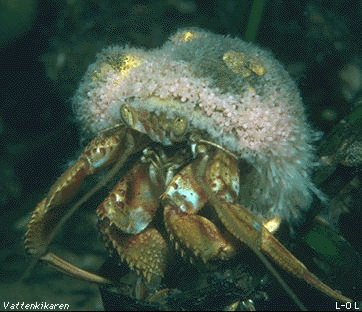|

Way
of life
|
|
More about the common hermit crab
Way of life

Hydroid polyps (Hydractinia
echinata)
The hermit crab protects its soft and sack like abdomen by sticking it
in an empty cone shell. Large hermit crabs live in empty whelk or neptunus
shells, smaller individuals live in moon shells, common
periwinkle shells or the shells of hinia
nitida.
The exterior of the shells are often covered with colony
building hydroid
polyps (Hydractinia echinata), which have stinging
cells. When the hermit has outgrown its shell and needs a larger one,
it will usually want to take its "pets" to the new shell. To accomplish
this, the hermit crab gently strokes the hydroids with its claw. Eventually
the hydroids became detached and can then be moved over to the new shell.
When the hermit crab has moved into its new shell, the opening is closed
with its large claw.

Common hermit crab covered with hydroid
polyps (Hydractinia echinata).
|
|
Page
1 of 2
|

|
|